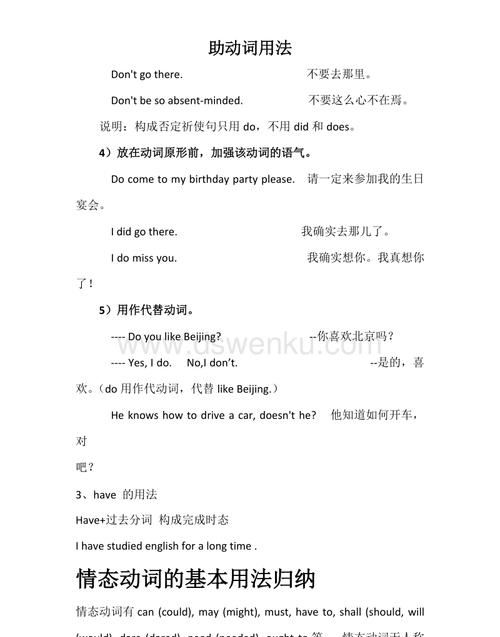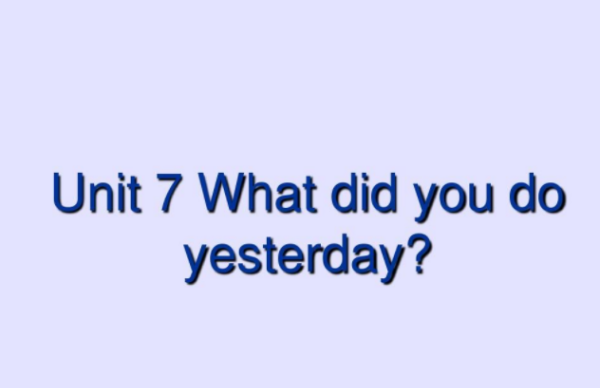本文目录
强调句的用法
强调句型的构成是:it
is
(was)
+
被强调部分+
that
(who)
+
句子的其他成分。被强调的部分放在
it
is
(was)
之后,其它部分置于that之后。被强调部分可以是主语,宾语,表语或状语。强调的主语如果是人,可以由who代替that。
1.
被强调的成分举例:
原句:tom
found
my
pen
in
the
classroom
yesterday.
强调主语:it
was
tom
who
/
that
found
my
pen
in
the
classroom
yesterday.
强调宾语:it
was
my
pen
that
tom
found
in
the
classroom
yesterday.
强调地点状语:it
was
in
the
classroom
that
tom
found
my
pen
yesterday.
强调时间状语:it
was
yesterday
that
tom
found
my
pen
in
the
classroom.
2.
强调句型的一般疑问式:
直接把is或was提到it之前即可。例如:
was
it
tom
that
found
your
pen
in
the
classroom
yesterday?
3.
强调句型的特殊疑问式:
特殊疑问词+
is
(was)
it
+
that
+句子的其他成分。特殊疑问词即是被强调的成分。例如:
who
was
it
that
found
your
pen
in
the
classroom
yesterday?
4.
that
(who)
有时可以省略:
这种强调句型中的that或who有时可以省略。例如:
it
was
my
brother
(that
/
whom)
you
saw
the
other
day.
5.
强调原因状语从句要注意:
若从句由as或since引导,强调时则改为because,这是因为,because引导的原因从句表示的意义非常强烈,符合强调句的目的。例如:
as
she
got
up
late,
she
missed
the
first
bus.
变为:
it
was
because
she
got
up
late
that
she
missed
the
bus.
6.
强调句的否定转移:
有些否定句在变成强调句时,要把否定转移到被强调的词语之前。尤其是“not...
until...”句式的强调要特别注意。例如:
he
didn't
realize
his
mistake
until
the
teacher
had
told
him.
变为:
it
wasn't
until
the
teacher
had
told
him
that
he
realized
his
mistake.
【注意】
在强调句式中,虽然not被提前,但“not...
until...”句型不要倒装。
高考中强调句型考查热点
考点一:强调句型的基本结构
强调句型“it
is
/
was
+
被强调的成份
+
that
+
其他成份”用来强调主语、宾语和状语等成份。that只起连接作用,不作成份,但不能省略。有时强调的部分比较特殊,如主语从句、状语从句、名词、不定式短语、v-ing的复合结构等。如:
it
was
in
the
library
that
i
saw
her
yesterday.
我昨天正是在图书馆见到她的。
考点二:特殊句式中的强调句型
1.
如果强调的是特殊疑问句中的疑问词,表示“到底”、“究竟”等语气时,就用如下结构:
“特殊疑问词
+
is
/
was
+
it
+
that
+
该句的其余部分”。如:
how
is
it
that
you
usually
go
to
work?
你通常是怎样去上班的?
2.
在强调“not...
until”结构中由until所引导的短语(或从句)作时间状语时,要用固定的强调句型:“it
+
is
/
was
+
not
until...
+
that
+
该句的其余部分”,that所引导的从句中的谓语动词用肯定式。如:
his
father
didn't
come
back
from
work
until
12
o'clock.
=
it
was
not
until
12
o'clock
that
his
father
came
home
form
work.
直到12点他的爸爸才下班回家。
考点三:强调句型与时间状语从句、定语从句的判断
强调句型要注意和it代表时间、距离、温度、自然现象、具体事物或人物等时所构成的各种句型的区别。试比较:
it
was
on
march
1
that
i
had
my
hair
cut.
(强调句)
it
was
march
1
when
i
had
my
hair
cut.
(后面是定语从句)
判断是否是强调句,可采用“还原法”。如果还原为一般句式后,句子各种成份完整,则是强调句。否则不是。如第一句可还原成:i
had
my
hair
cut
on
march
1.
考点四:偶尔考查谓语动词的强调句式
英语中常用助动词do、does或did强调谓语。如:
he
did
go
to
the
airport
yesterday,
but
he
didn't
find
you.
他昨天确实去了机场,但他没有找到你。

助动词表示强调的用法
助动词表示强调,放在动词前面,根据时态、单数、复数的不同,其形式可以是do,did,does。
助动词后面的动词用原形。如:
1. He does like me.
2. Tom did come here yesterday.
3. They do have nothing to say.

do
英 [duː , də , dəʊ] 美 [duː , də , doʊ].
v.(以某种方式)做;办(某事);行动;表现;(问询或谈论时用)进展。
aux.用于实义动词前构成否定句和疑问句;构成附加疑问句;代替实义动词以避免重复。
n.社交聚会;社交活动。
n.(口语)事件;(主英国口语)诈骗;(主英国、新西兰口语)宴会;(口语)必须做到的事情。
第三人称单数:does.
复数:dos.
现在分词:doing.
过去式:did.
过去分词:done.
英语be动词和助动词的用法
英语常见助动词的用法
协助主要动词构成谓语的词叫助动词,也叫辅助动词。被协助的动词称作主要动词。助动词用来构成时态和语态。下面是我帮大家整理的英语常见助动词的.用法,欢迎大家分享。

英语常见助动词的用法
常见助动词:
be(无词义),do/does/did(无词义),have(无词义),shall 将要,will 将要。
分类
半助动词
在功能上介于主动词和助动词之间的一类结构,称为半助动词。
常见的半助动词有:
be to, be about to, be due to, be going to, be likely to, be meant to,
be obliged to, be supposed to, be willing to, have to, seem to,
be unable to, be unwilling to. 等。
情态助动词
1.情态助动词包括will(would), shall(should), can(could), may(might), must, need to, dare to, ought to, used to, had better,有词汇意义,后接动词原形(没有to的不定式)。
2.情态助动词没有主语是第三人称单数时,词尾不加s。
如:She will come here.(√)
She wills come here.(×) will后不加S
情态助动词不受主语的人称和数的限制。
3.两个情态助动词不能连用。
基本助动词
基本助动词只有三个:be, do, have, 它们没有词汇意义,只有语法作用,如协助构成进行体,完成体,被动态,否定句,疑问句等。 例如:
He is giving a lecture. 他在作报告。
He has made a plan. 他已经订了计划。
The small animals are kept in the cages. 小动物都关在笼子里。
一、be 的助动词用法
be 作为助动词,用来构成进行时态和被动语态。如:
We are working hard in the garden.(构成现在进行时)
我们在花园里辛勤劳动。
The house was painted purple.(构成被动语态)
房子被刷成紫色的。
二、do 的助动词用法
do 作为助动词,用来构成疑问句、否定句、强调句。
1) 构成一般疑问句
例如:Do you want to pass the CET? 你想通过大学英语测试吗?
Did you study German? 你们学过德语吗?
2) do + not 构成否定句
例如:I do not want to be criticized. 我不想挨批评。
He doesn't like to study. 他不想学习。
In the past, many students did not know the importance of English. 过去,好多学生不知道英语的重要性。
3) 构成否定祈使句
例如:Don't go there. 不要去那里。
Don't be so absent-minded. 不要这么心不在焉。
说明: 构成否定祈使句只用do,不用did和does。
4) 放在动词原形前,加强该动词的语气
例如:Do come to my birthday party. 一定来参加我的生日宴会。
I did go there. 我确实去那儿了。
I do miss you. 我确实想你。
5) 用于倒装句
例如:Never did I hear of such a thing. 我从未听说过这样的事情。
Only when we begin our college life do we realize the importance of English.
只有在开始大学生活时我们才认识到英语的重要性。
说明: 引导此类倒装句的副词有never, seldom, rarely, little, only, so, well等。
6) 用作代动词
例如: Do you like Beijing? --你喜欢北京吗?Yes, I do. --是的,喜欢。(do用作代动词,代替like Beijing.)
He knows how to drive a car, doesn't he?他知道如何开车,对吧?
三、have 的助动词用法
have 作为助动词,用来构成完成时态。如:
1)have +过去分词,构成完成时态。
例如:He has left for London. 他已去了伦敦。
By theendof last month, they had finished half of their work. 上月未为止,他们已经完成工作的一半。
2)have + been +现在分词,构成完成进行时。
例如:I have been studying English for ten years. 我一直在学英语,已达十年之久。
3)have +been +过去分词,构成完成式被动语态。
例如:English has been taught in China for many years.中国教英语已经多年。
;强调句型结构及用法思维导图
1、陈述句的强调句型
It is/ was +被强调部分(通常是主语、宾语或状语)+that/ who(当强调主语且主语指人)+其他部分。
例子:It was yesterday that he met Li Ping.他是昨天遇见李平的。
2、一般疑问句的强调句型
同上,只是把is/ was提到it前面。
例子:Was it yesterday that he met Li Ping?他是昨天遇见李平的吗?
3、特殊疑问句的强调句型
被强调部分(通常是疑问代词或疑问副词)+is/ was + it + that/ who +其他部分?
例子:When and where was it that you were born?你是什么时候在哪里出生的?

4、not…until…句型的强调句
句型为:It is/ was not until +被强调部分+that +其他部分
例子:It was not until his wife came back that he went to bed.直到他妻子回来,他才上床睡觉。
5、谓语动词的强调
A. It is/ was ... that ...结构不能强调谓语,如果需要强调谓语时,用助动词do/ does或did
例子:Do be careful when you cross the street.过马路时,务必(千万)要小心啊!
以上就是关于助动词强调句用法 ,强调句的用法的全部内容,以及助动词强调句用法 的相关内容,希望能够帮到您。

